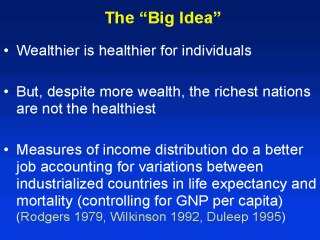| front |1 |2 |3 |4 |5 |6 |7 |8 |9 |review |
 |
In industrialized countries when we study large groups of
individuals, people with higher socio-economic status self-report better health and have
lower morbidity and mortality than those in lower SES groups. This relationship holds up
over time and across space- and it doesnít seem to matter what the leading causes of
death are - whatever is going around, poor people tend to get it. Given this relationship at the individual level we might expect that the richest countries would also have the healthiest populations (measured be life expectancy or age-standardized mortality rates). But when people like Rogers and more recently Richard Wilkinson began to look at the relationship between an abolute measure of wealth like GNP per capita they found that higher GNP is associated with lower mortality only at very low levels of GNP. So after about $5000 per capita the relationship virtually disappears. The wealthiest of the wealthy countries like the United States and Germany donít fare as well in terms of life expectancy as poorer more egalitarian societies like Iceland or Greece. But Wilkinson then showed that mortality in the industrialized countries was associated with how income is distributed within those countries. Controlling for average national incomes did not affect this association. |